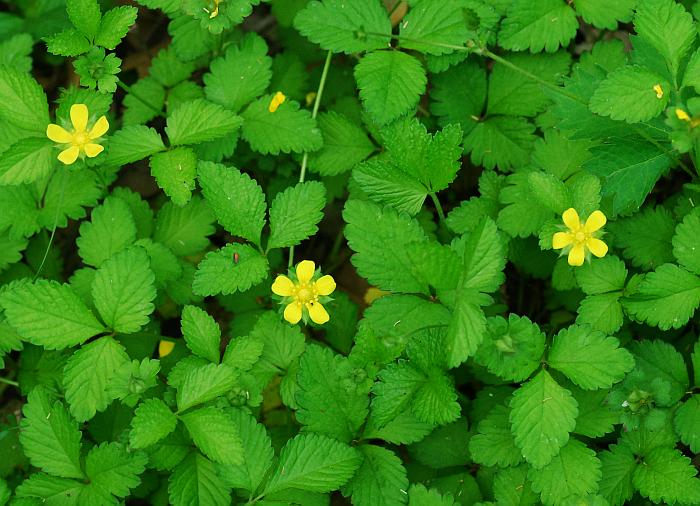Duchesnea indica (Andrews) Teschem.
Indian Strawberry

Introduced
CC = *
CW = 3
MOC = 15
© SRTurner
Duchesnea indica (Andrews) Teschem.Indian Strawberry | |
 |
Introduced CC = * CW = 3 MOC = 15 |
© SRTurner |
|
Family - Rosaceae Habit - Perennial forb with short rhizomes. Stems - Prostrate, trailing, and stolonlike, to 80 cm, rooting at some nodes, unarmed, hairy.
Leaves - Rosettes at the rhizome tips and where the aerial stems root, otherwise alternate, long-petiolate, trifoliate. Stipules 4-9 mm long, herbaceous, narrowly oblong-elliptic, hairy, those of the rosette leaves fused toward the base. Petioles to 6 cm long, antrorsely pubescent. Leaf blades 1-7 cm long, broadly ovate-triangular in outline, divided into 3 similar leaflets, these 1.0-6.5 cm long, elliptic or ovate, rounded to more commonly pointed at the tip, rounded or narrowed to a short-stalked base, the margins bluntly toothed or scalloped, the surfaces sparsely to moderately appressed-hairy, especially along the veins.
Inflorescences - Flowers solitary in the leaf axils (and among the rosette leaves), long-stalked, each with 5 bractlets beneath and alternating with the sepals, these noticeably wider than the sepals, broadly obovate, prominently 3-toothed or -lobed at the tip, becoming somewhat enlarged and reflexed at fruiting Flowers - Perigynous, perfect. Sepals 5, 4-7 mm long, usually arched upward, ovate-triangular, sparsely to moderately hairy, somewhat enlarged at fruiting. Petals 5, 5-9 mm long, narrowly obovate, yellow. Stamens 15-25, the anthers yellow. Pistils numerous, densely covering the surface of the obconic expanded receptacle. Ovary superior, glabrous, with 1 locule, with 1 ovule. Style 1 per pistil, attached laterally, shed before the fruit matures, the stigma disc-shaped.
Fruits - Achenes, in a headlike cluster densely covering the surface of the enlarged expanded receptacle, but shed eventually, 0.9-1.5 mm long, asymmetrically ovate in outline, glabrous, shiny, red.
Flowering - April - June. Habitat - Lawns, forest openings, open disturbed areas. Origin - Native to Asia. Lookalikes - Flowers resemble those of Potentilla species. Fruits resemble those of Fragaria species. Other info. - Anyone who tastes the fruits of this plant is in for a rude surprise. Despite their luscious appearance, the fruits are dry and insipid and nothing at all like a real strawberry. As of early 2019, this introduced species has been reported from 15 counties in Missouri, up from the 4 counties reported in Steyermark's 1963 publication. It is likely to be more common than collections indicate. Beyond Missouri it also occurs in most of the eastern half of the U.S. Photographs taken in Rockwoods Reservation, St. Louis County, MO, 5-22-2010, along Riverfront Park in Washington, Franklin County, MO, 5-5-2014 and 6-4-2020, and near Labadie, Franklin County, MO, 4-28-2019 (SRTurner). |